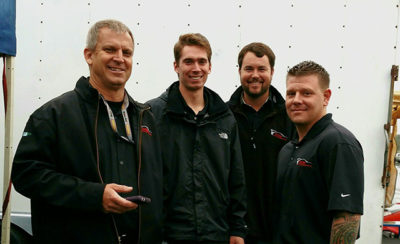Why is it that car companies race their product? In the beginnings of the auto industry, some would say since the second car was built, the innovators who built them have always sought to measure themselves against their competitors by pitting their cars against others. Originally these were tests of endurance to prove who had built the car most capable of running for long distances. The first INDY 500 run in 1911 took almost seven hours for the winner to complete while in Europe, races such as the Gordon Bennett Cup were well established as long distance tests of man and machine since as early as 1900. The most famous – and longest running – endurance race of them all, the 24 Hours of Le Mans, first took place in 1923.
From these beginnings, throughout the twentieth century, car people continued to make advances in technology and showcase that technology on racetracks around the world. Racing served as the incubator for technology and a way to rapidly test innovations and for many brands, still does today. However, the commercialization of the sport in the mid and late twentieth century also brought a need for entertainment to motor racing. The races became bigger and the stars became household names. And because of the need to build entertainment, the rules governing racing became ever stricter. The windows of opportunity to innovate technology are smaller now than in times past and the level of technology being used in production car development is so high that the direction of technology transfer has reversed in some cases. While the first known case of an integrated rear view mirror used on a car was in that original 1911 Indy 500 (on Ray Harroun’s winning Marmon Wasp), the current Mazda RT24-P IMSA DPi Prototype, like many modern racing cars, uses an always on rear camera system, developed for road car use first.
Despite the narrowing window for technological innovation, one part of the original lure of motor racing remains as strong and perhaps stronger than ever and that is the challenge of measuring yourself – against competition and more importantly against your own boundaries. Motor racing is a sport that has always been driven by the need to go beyond expectations and to find and activate the challenger spirit that lives within.
Mazda has always been driven by its strong challenger spirit. Is it a basic human instinct that leads us to explore and break boundaries? From going to the Moon and next to Mars, to climbing the highest mountains and exploring the deepest oceans, mankind has a thirst for overcoming challenges in search of fulfillment and meaning. It is what it means to feel alive (Hashiru Yorokobi). For Mazda and many of our racing community, that challenger spirit manifests itself most clearly on the race track
In the case of Mazda, overcoming the devastation of Hiroshima, the hometown of the now 100-year-old brand, in 1945 is a key moment in the forging of this challenger spirit. Many cities and brands would have struggled to find the heart to recover from such an event, but the wonderful city of Hiroshima and its home-grown car brand did just that and rose to meet the next challenge. They did not have to wait long as they were soon to license new technology (Wankel Rotary) in order to innovate their way to a place among more conventional car brands. In 1967 Mazda launched the first rotary powered sports car, the iconic Cosmo 110s in a world of big V8s, and almost immediately (in 1968) took it to an 84-hour endurance race in Germany. Mazda first entered the 24 Hours of Le Mans in 1970 and returned for 18 times in the following 21 years before winning against all odds in 1991. In 1989 when the world of the two-seat roadster had just about collapsed, Mazda launched the Miata, and with over 1 million built since then, it is now widely accepted as the most raced sports car in the world. Building and racing a production diesel and winning a Grand Am championship with it, taking on the world’s best premium carmakers in prototype racing and winning…these are all examples of Mazda rising to meet challenges. For these reasons, Mazda is beloved by an army of loyal cognoscenti for whom the brand represents the challenger spirit in their own lives.
For Mazda, racing is a manifestation of our thirst to find and meet challenges, of our drive to be our best selves and this serves a metaphor for the brand and an inspiration for Mazda fans and hopefully the loyal racers who each week make sure more Mazdas are road raced on U.S. race tracks than any other brand. One gentlemen with whom we know this resonates, Steve Bertok, was awarded the Spirit of Mazda award for just this.


 ACCESSIBILITY
ACCESSIBILITY